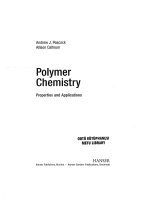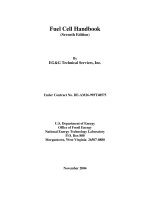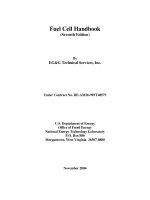Seymour carrahers polymer chemistry, seventh edition
Bạn đang xem bản rút gọn của tài liệu. Xem và tải ngay bản đầy đủ của tài liệu tại đây (11.96 MB, 729 trang )
Seymour/Carraher’s
Polymer
Chemistry
Seventh Edition
ß 2006 by Taylor & Francis Group, LLC.
ß 2006 by Taylor & Francis Group, LLC.
Seymour/Carraher’s
Polymer
Chemistry
Seventh Edition
Charles E. Carraher, Jr.
Florida Atlantic University
Boca Raton, Florida, U.S.A.
ß 2006 by Taylor & Francis Group, LLC.
CRC Press
Taylor & Francis Group
6000 Broken Sound Parkway NW, Suite 300
Boca Raton, FL 33487-2742
© 2008 by Taylor & Francis Group, LLC
CRC Press is an imprint of Taylor & Francis Group, an Informa business
No claim to original U.S. Government works
Printed in the United States of America on acid-free paper
10 9 8 7 6 5 4 3 2 1
International Standard Book Number-10: 1-4200-5102-4 (Hardcover)
International Standard Book Number-13: 978-1-4200-5102-5 (Hardcover)
This book contains information obtained from authentic and highly regarded sources. Reprinted material is quoted
with permission, and sources are indicated. A wide variety of references are listed. Reasonable efforts have been made to
publish reliable data and information, but the author and the publisher cannot assume responsibility for the validity of
all materials or for the consequences of their use.
No part of this book may be reprinted, reproduced, transmitted, or utilized in any form by any electronic, mechanical, or
other means, now known or hereafter invented, including photocopying, microfilming, and recording, or in any information storage or retrieval system, without written permission from the publishers.
For permission to photocopy or use material electronically from this work, please access www.copyright.com (http://
www.copyright.com/) or contact the Copyright Clearance Center, Inc. (CCC) 222 Rosewood Drive, Danvers, MA 01923,
978-750-8400. CCC is a not-for-profit organization that provides licenses and registration for a variety of users. For organizations that have been granted a photocopy license by the CCC, a separate system of payment has been arranged.
Trademark Notice: Product or corporate names may be trademarks or registered trademarks, and are used only for
identification and explanation without intent to infringe.
Library of Congress Cataloging-in-Publication Data
Carraher, Charles E.
Seymour/Carraher’s polymer chemistry. -- Seventh edition / by Charles E. Carraher, Jr.
p. cm.
Includes bibliographical references and index.
ISBN-13: 978-1-4200-5102-5
ISBN-10: 1-4200-5102-4
1. Polymers. 2. Polymerization. I. Seymour, Raymond Benedict, 1912- II. Title. III. Title: Polymer
chemistry.
QD381.S483 2007
547’.7--dc22
Visit the Taylor & Francis Web site at
and the CRC Press Web site at
ß 2006 by Taylor & Francis Group, LLC.
2007002479
Foreword
Polymer science and technology have developed tremendously over the last few decades, and
the production of polymers and plastics products has increased at a remarkable pace. By the
end of 2000, nearly 200 million tons per year of plastic materials were produced worldwide
(about 2% of the wood used, and nearly 5% of the oil harvested) to fulfill the ever-growing
needs of the plastic age; in the industrialized world plastic materials are used at a rate of
nearly 100 kg per person per year. Plastic materials with over $250 billion per year contribute
about 4% to the gross domestic product in the United States. Plastics have no counterpart in
other materials in terms of weight, ease of fabrication, efficient utilization, and economics.
It is no wonder that the demand and the need for teaching in polymer science and
technology have increased rapidly. To teach polymer science, a readable and up-to-date
introductory textbook is required that covers the entire field of polymer science, engineering,
technology, and the commercial aspect of the field. This goal has been achieved in Carraher’s
textbook. It is eminently useful for teaching polymer science in departments of chemistry,
chemical engineering, and material science, and also for teaching polymer science and
technology in polymer science institutes, which concentrate entirely on the science and
technologies of polymers.
This seventh edition addresses the important subject of polymer science and technology,
with emphasis on making it understandable to students. The book is ideally suited not only
for graduate courses but also for an undergraduate curriculum. It has not become more
voluminous simply by the addition of information—in each edition less important subjects
have been removed and more important issues introduced.
Polymer science and technology is not only a fundamental science but also important
from the industrial and commercial point of view. The author has interwoven discussion of
these subjects with the basics in polymer science and technology. Testimony to the high
acceptance of this book is that early demand required reprinting and updating of each of the
previous editions. We see the result in this new significantly changed and improved edition.
Otto Vogl
Herman F. Mark Professor Emeritus
Department of Polymer Science and Engineering
University of Massachusetts
Amherst, Massachusetts
ß 2006 by Taylor & Francis Group, LLC.
ß 2006 by Taylor & Francis Group, LLC.
Preface
As with most science, and chemistry in particular, there is an explosive broadening and
importance of the application of foundational principles of polymers. This broadening is
seen in ever-increasing vistas allowing the promotion of our increasingly technologically
dependent society and solutions to society’s most important problems in areas such as the
environment and medicine. Some of this broadening is the result of extended understanding
and application of already known principles but also includes the development of basic
principles and materials known to us hardly a decade ago. Most of the advancements in
communication, computers, medicine, air and water purity are linked to macromolecules and
a fundamental understanding of the principles that govern their behavior. Much of this
revolution is of a fundamental nature and is explored in this seventh edition. The text contains
these basic principles and also touches on their application to real-life situations. Technology
is the application of scientific principles. In polymers there is little if any division between
science and technology.
Polymers are found in the organic natural world as the building blocks for life itself. They
are also found as inorganic building blocks that allow construction of homes, skyscrapers,
and roads. Synthetic polymers serve as basic building blocks of society now and in the future.
This text includes all three of these critical segments of polymeric materials.
A basic understanding of polymers is essential to the training of today’s science, biomedical, and engineering students. Polymer Chemistry complies with the American Chemical
Society’s Committee on Professional Training old and revised guidelines as an advanced or
in-depth course. It naturally integrates and interweaves the important core areas since
polymers are critical to all of the core areas, which in turn contribute to the growth of
polymer science. Most of the fundamental principles of polymers extend and enhance similar
principles found throughout the undergraduate and graduate training of students. This allows
students to integrate their chemical knowledge illustrating the connection between fundamental and applied chemical information. Thus, along with the theoretical information,
application is integrated as an essential part of the information. As in other areas such as
business and medicine, short case studies are integrated as historical material.
While this text is primarily written as an introductory graduate-level text, it can also be
used as an undergraduate text, or as an introductory undergraduate–graduate text. The topics
are arranged so that the order and inclusion or exclusion of chapters or parts of chapters will
still allow students an adequate understanding of the science of polymers. Most of the
chapters begin with the theory followed by application. The most important topics are
generally at the beginning of the chapter followed by important, but less critical, sections.
Some may choose to study the synthesis-intense chapters first, others the analytical=
analysis=properties chapters, and yet others to simply read the chapters as they appear in
the book. All of the elements of an introductory text with synthesis, property, application and
characterization are present, allowing this to be the only polymer course taken by an
individual or the first in a series of polymer-related courses taken by the student.
This edition continues in the ‘‘user-friendly’’ mode with special sections in each chapter
containing definitions, learning objectives, questions, and further reading. Application and
theory are integrated so that they reinforce one another. There is a continued emphasis on
pictorializing, reinforcing, interweaving, and integrating basic concepts. The initial chapter is
short, allowing students to become acclimated. Other chapters can be covered in about a
ß 2006 by Taylor & Francis Group, LLC.
week’s time or less. Where possible, difficult topics are distributed and reinforced over several
topics.
The basic principles that apply to synthetic polymers apply equally to inorganic and
biological polymers and are present in each of the chapters covering these important polymer
groupings.
The updating of analytical, physical, and special characterization techniques continues.
The chapter on biological polymers has been expanded so that it is now two chapters. The
chapter on organometallic and inorganic polymers has likewise been greatly upgraded. An
additional chapter covering the important area of composites has been added. Topics such as
blends, multiviscosity oils, cross-linking, microfibers, protein folding, protein site identification, aerogels, carbon nanotubes, breakage of polymer chains, permeability and diffusion,
mass spectroscopy, polyethers and epoxies, synthetic rubbers, poly(methyl methacrylate),
polyacrylonitrile, and polyurethanes have been added or greatly enhanced. A number of
new selected topics have been added including nonlinear optical behavior, photo physics,
drug design and activity, flame retardants, textiles, water-soluble polymers, hydrogels, and
anaerobic adhesives. The emphasis on the molecular behavior of materials has been expanded
as has been the emphasis on nanotechnology and nanomaterials. The practice of including a
number of appendices has continued, including an enlargement of the trade names appendix.
ß 2006 by Taylor & Francis Group, LLC.
Acknowledgments
The author gratefully acknowledges the contributions and assistance of the following in
preparing this text: John Droske, Charles Pittman, Edward Kresge, Gerry Kirshenbaum,
Sukumar Maiti, Alan MacDiarmid, Les Sperling, Eckhard Hellmuth, Mike Jaffe, Otto Vogl,
Thomas Miranda, Murry Morello, and Graham Allan; and a number of our children who
assisted in giving suggestions for the text: Charles Carraher III, Shawn Carraher, Colleen
Carraher-Schwarz, Erin Carraher, and Cara Carraher—to Erin for discussions on materials,
Cara for her help with the biomedical material, and Shawn for his help in relating the business
and industrial aspects. Special thanks to Gerry Kirshenbaum for his kind permission to utilize
portions of my articles that appeared in Polymer News. This book could not have been written
except for those who have gone before us, especially Raymond Seymour, Herman Mark,
Charles Gebelein, Paul Flory, and Linus Pauling; all of these friends shepherded and helped
me. My thanks to them.
I thank Girish Barot, Amitabh Battin, and Randy Doucette, for their assistance in
proofing. I also thank my wife Mary Carraher for her help in proofing and allowing this
edition to be written.
ß 2006 by Taylor & Francis Group, LLC.
ß 2006 by Taylor & Francis Group, LLC.
Table of Contents
Chapter 1
Introduction to Polymers
1.1
History of Polymers
1.2
Why Polymers?
1.3
Today’s Marketplace
1.4
Summary
Glossary
Exercises
Further Reading
General Encyclopedias and Dictionaries
Chapter 2
Polymer Structure (Morphology)
2.1
Stereochemistry of Polymers
2.2
Molecular Interactions
2.3
Polymer Crystals
2.4
Amorphous Bulk State
2.5
Polymer Structure–Property Relationships
2.6
Cross-Linking
2.7
Crystalline and Amorphous Combinations
2.8
Summary
Glossary
Exercises
Additional Reading
Chapter 3
Molecular Weight of Polymers
3.1
Introduction
3.2
Solubility
3.3
Average Molecular Weight Values
3.4
Fractionation of Polydisperse Systems
3.5
Chromatography
3.6
Colligative Molecular Weights
3.6.1 Osmometry
3.6.2 End-Group Analysis
3.6.3 Ebulliometry and Cryometry
3.7
Light-Scattering Photometry
3.8
Other Techniques
3.8.1 Ultracentrifugation
3.8.2 Mass Spectrometry
3.9
Viscometry
3.10 Summary
ß 2006 by Taylor & Francis Group, LLC.
1
1
8
12
16
17
17
17
18
19
20
27
34
38
38
41
42
45
46
47
48
49
49
51
53
59
59
62
62
64
64
64
70
70
72
72
78
Glossary
Exercises
Further Reading
79
80
82
Chapter 4
Polycondensation Polymers (Step-Reaction Polymerization)
4.1
Comparison between Polymer Type and Kinetics of Polymerization
4.2
Introduction
4.3
Stepwise Kinetics
4.4
Polycondensation Mechanisms
4.5
Polyesters
4.6
Polycarbonates
4.7
Synthetic Polyamides
4.8
Polyimides
4.9
Polybenzimidazoles and Related Polymers
4.10 Polyurethanes and Polyureas
4.11 Polysulfides
4.12 Polyethers and Epoxys
4.13 Polysulfones
4.14 Poly(ether ketone) and Polyketones
4.15 Phenolic and Amino Plastics
4.16 Furan Resins
4.17 Synthetic Routes
4.18 Liquid Crystals
4.19 Microfibers
4.20 General Stepwise Polymerization
4.21 Summary
Glossary
Exercises
Further Reading
83
83
88
88
92
94
100
103
109
110
110
113
114
117
119
120
122
122
123
127
128
130
131
133
134
Chapter 5
Ionic Chain-Reaction and Complex Coordination
Polymerization (Addition Polymerization)
5.1
Chain-Growth Polymerization—General
5.2
Cationic Polymerization
5.3
Anionic Polymerization
5.4
Stereoregularity and Stereogeometry
5.5
Polymerization with Complex Coordination Catalysts
5.6
Soluble Stereoregulating Catalysis
5.7
Polyethylenes
5.8
Polypropylene
5.9
Polymers from 1,4-Dienes
5.10 Polyisobutylene
5.11 Metathesis Reactions
5.12 Zwitterionic Polymerization
5.13 Isomerization Polymerization
5.14 Precipitation Polymerization
5.15 Summary
ß 2006 by Taylor & Francis Group, LLC.
135
136
137
143
148
148
150
153
158
162
164
165
165
166
167
167
Glossary
Exercises
Further Reading
168
169
170
Chapter 6
Free Radical Chain Polymerization (Addition Polymerization)
6.1
Initiators for Free Radical Chain Polymerization
6.2
Mechanism for Free Radical Chain Polymerization
6.3
Chain Transfer
6.4
Polymerization Techniques
6.4.1 Bulk Polymerization
6.4.2 Suspension Polymerization
6.4.3 Solution Polymerization
6.4.4 Emulsion Polymerization
6.5
Fluorine-Containing Polymers
6.6
Polystyrene
6.7
Poly(vinyl chloride)
6.8
Poly(methyl methacrylate)
6.9
Poly(vinyl alcohol) and Poly(vinyl acetals)
6.10 Poly(acrylonitrile)
6.11 Solid State Irradiation Polymerization
6.12 Plasma Polymerizations
6.13 Summary
Glossary
Exercises
Further Reading
173
173
177
183
185
185
187
187
187
190
193
194
197
199
200
201
202
203
203
204
205
Chapter 7
Copolymerization
7.1
Kinetics of Copolymerization
7.2
The Q–e Scheme
7.3
Commercial Copolymers
7.4
Block Copolymers
7.5
Graft Copolymers
7.6
Elastomers
7.7
Thermoplastic Elastomers
7.8
Blends
7.8.1 Immiscible Blends
7.8.2 Miscible Blends
7.9
Networks—General
7.10 Polymer Mixtures
7.11 Dendrites
7.12 Ionomers
7.13 Viscosity Modifiers
7.14 Summary
Glossary
Exercises
Further Reading
207
208
212
213
214
216
216
218
221
221
223
224
225
226
228
229
233
234
235
236
ß 2006 by Taylor & Francis Group, LLC.
Chapter 8
Composites and Fillers
8.1
Fillers
8.2
Types of Composites
8.3
Long Fiber Composites—Theory
8.4
Fibers and Resins
8.5
Long Fiber Composites—Applications
8.6
Nanocomposites
8.7
Fabrication
8.7.1 Processing of Fiber-Reinforced Composites
8.7.2 Structural Composites
8.7.3 Laminating
8.7.4 Particulate
8.8
Metal–Matrix Composites
8.9
Summary
Glossary
Exercises
Further Reading
237
237
238
240
242
244
248
251
251
251
252
252
253
256
256
257
257
Chapter 9
Naturally Occurring Polymers: Plants
9.1
Polysaccharides
9.2
Cellulose
9.2.1 Paper
9.3
Cellulose-Regenerating Processes
9.4
Esters and Ethers of Cellulose
9.4.1 Inorganic Esters
9.4.2 Organic Esters
9.4.3 Organic Ethers
9.5
Starch
9.6
Homopolysaccharides
9.6.1 Fructans
9.6.2 Chitin and Chitosan
9.6.3 Others
9.7
Heteropolysaccharides
9.8
Synthetic Rubbers
9.9
Naturally Occurring Polyisoprenes
9.10 Resins
9.11 Balloons
9.12 Lignin
9.13 Melanins
9.14 Summary
Glossary
Exercises
Further Reading
259
260
261
263
265
268
268
269
270
272
275
277
278
279
279
283
289
291
292
293
295
296
297
298
299
Chapter 10
Naturally Occurring Polymers: Animals
10.1 Proteins
10.2 Levels of Protein Structure
301
302
305
ß 2006 by Taylor & Francis Group, LLC.
10.2.1
10.2.2
Primary Structure
Secondary Structure
10.2.2.1 Keratins
10.2.2.2 Silk
10.2.2.3 Wool
10.2.2.4 Collagen
10.2.2.5 Elastin
10.2.3 Tertiary Structure
10.2.3.1 Globular Proteins
10.2.4 Quaternary Structure
10.3
Nucleic Acids
10.4
Flow of Biological Information
10.5
RNA Interference
10.6
Polymer Structure
10.7
Protein Folding
10.8
Genetic Engineering
10.9
DNA Profiling
10.10 The Human Genome: General
10.11 Chromosomes
10.12 Proteomics
10.13 Protein Site Activity Identification
10.14 Summary
Glossary
Exercises
Further Reading
305
305
308
309
311
311
312
312
312
314
316
321
323
325
328
330
333
335
341
352
354
354
355
358
358
Chapter 11
Organometallic and Inorganic–Organic Polymers
11.1
Introduction
11.2
Inorganic Reaction Mechanisms
11.3
Condensation Organometallic Polymers
11.3.1 Polysiloxanes
11.3.2 Organotin and Related Condensation Polymers
11.4
Coordination Polymers
11.4.1 Platinum-Containing Polymers
11.5
Addition Polymers
11.5.1 Ferrocene-Containing and Related Polymers
11.5.2 Polyphosphazenes and Related Polymers
11.5.3 Boron-Containing Polymers
11.6
Ion-Exchange Resins
11.7
Summary
Glossary
Exercises
Further Reading
361
361
362
364
365
368
370
372
373
374
375
377
378
380
380
380
381
Chapter 12
Inorganic Polymers
12.1
Introduction
12.2
Portland Cement
12.3
Other Cements
383
383
383
386
ß 2006 by Taylor & Francis Group, LLC.
12.4
Silicates
12.4.1 Network
12.4.2 Layer
12.4.3 Chain
12.5
Silicon Dioxide (Amorphous)
12.6
Kinds of Amorphous Glass
12.7
Safety Glass
12.8
Lenses
12.9
Sol–Gel
12.9.1 Aerogels
12.10 Silicon Dioxide (Crystalline Forms)—Quartz Forms
12.11 Silicon Dioxide in Electronic Chips
12.12 Silicon Dioxide in Optical Fibers
12.13 Asbestos
12.14 Polymeric Carbon—Diamond
12.15 Polymeric Carbon—Graphite
12.16 Internal Cyclization—Carbon Fibers and Related Materials
12.17 Carbon Nanotubes
12.17.1 Structures
12.18 Bitumens
12.19 Carbon Black
12.20 Polysulfur
12.21 Ceramics
12.22 High-Temperature Superconductors
12.22.1 Discovery of the 123-Compound
12.22.2 Structure of the 123-Compound
12.23 Zeolites
12.24 Summary
Glossary
Exercises
Further Reading
Chapter 13
Testing and Spectrometric Characterization of Polymers
13.1
Spectronic Characterization of Polymers
13.1.1 Infrared Spectroscopy
13.1.2 Raman Spectroscopy
13.1.3 Nuclear Magnetic Resonance Spectroscopy
13.1.4 Nuclear Magnetic Resonance Applications
13.1.5 Electron Paramagnetic Resonance Spectroscopy
13.1.6 X-Ray Spectroscopy
13.2
Surface Characterization
13.2.1 Auger Electron Spectroscopy and X-Ray
Photoelectron Spectroscopy
13.2.2 Near-Field Scanning Optical Microscopy
13.2.3 Electron Microscopy
13.2.4 Scanning Probe Microscopy
13.2.5 Secondary Ion Mass Spectroscopy
13.3
Amorphous Region Determinations
13.4
Mass Spectrometry
ß 2006 by Taylor & Francis Group, LLC.
386
389
389
390
390
393
394
396
398
399
401
403
403
404
405
405
407
408
409
414
415
417
417
419
419
419
420
421
422
423
424
425
426
426
427
427
429
429
430
430
431
431
432
432
435
436
436
Thermal Analysis
Thermal Property Tests
13.6.1
Softening Range
13.6.2
Heat Deflection Temperature
13.6.3
Glass Transition Temperatures
13.6.4
Thermal Conductivity
13.6.5
Thermal Expansion
13.7
Flammability
13.8
Electrical Properties: Theory
13.9
Electric Measurements
13.9.1
Dielectric Constant
13.9.2
Electrical Resistance
13.9.3
Dissipation Factor and Power Loss
13.9.4
Electrical Conductivity and Dielectric Strength
13.10 Optical Properties Tests
13.10.1 Index of Refraction
13.10.2 Optical Clarity
13.10.3 Absorption and Reflectance
13.11 Weatherability
13.12 Chemical Resistance
13.13 Measurement of Particle Size
13.14 Measurement of Adhesion
13.15 Permeability and Diffusion
13.16 Summary
Glossary
Exercises
Further Reading
437
439
440
440
440
441
442
442
443
445
446
446
446
447
448
449
449
450
450
450
451
452
453
455
456
456
457
Chapter 14
Rheology and Physical Tests
14.1
Rheology
14.1.1
Rheology and Physical Tests
14.1.2
Response Time
14.2
Typical Stress–Strain Behavior
14.3
Stress–Strain Relationships
14.4
Specific Physical Tests
14.4.1
Tensile Strength
14.4.2
Tensile Strength of Inorganic and Metallic Fibers and Whiskers
14.4.3
Compressive Strength
14.4.4
Impact Strength
14.4.5
Hardness
14.4.6
Brinell Hardness
14.4.7
Rockwell Hardness
14.4.8
Shear Strength
14.4.9
Abrasion Resistance
14.4.10 Failure
14.5
Summary
Glossary
Exercises
Further Reading
459
459
462
465
465
469
471
471
473
474
474
475
476
476
478
478
478
479
479
480
481
13.5
13.6
ß 2006 by Taylor & Francis Group, LLC.
Chapter 15
Additives
15.1
Plasticizers
15.2
Antioxidants
15.3
Heat Stabilizers
15.4
Ultraviolet Stabilizers
15.5
Flame Retardants
15.6
Colorants
15.7
Curing Agents
15.8
Antistatic Agents—Antistats
15.9
Chemical Blowing Agents
15.10 Compatibilizers
15.11 Impact Modifiers
15.12 Processing Aids
15.13 Lubricants
15.14 Microorganism Inhibitors
15.15 Summary
Glossary
Exercises
Further Reading
483
484
487
489
489
490
491
491
492
492
492
492
492
493
493
493
494
495
495
Chapter 16
Reactions on Polymers
16.1
Reactions with Polyolefines and Polyenes
16.2
Reactions of Aromatic and Aliphatic Pendant Groups
16.3
Degradation
16.4
Cross-Linking
16.5
Reactivities of End Groups
16.6
Supramolecules and Self-Assembly
16.7
Transfer and Retention of Oxygen
16.8
Nature’s Macromolecular Catalysts
16.9
Mechanisms of Energy Absorption
16.10 Breakage of Polymeric Materials
16.11 Summary
Glossary
Exercises
Further Reading
497
497
498
499
501
503
504
511
515
519
521
523
523
524
524
Chapter 17
Synthesis of Reactants and Intermediates for Polymers
17.1
Monomer Synthesis from Basic Feedstocks
17.2
Reactants for Step-Reaction Polymerization
17.3
Synthesis of Vinyl Monomers
17.4
Synthesis of Free Radical Initiators
17.5
Summary
Glossary
Exercises
Further Reading
525
525
530
536
540
542
542
543
543
ß 2006 by Taylor & Francis Group, LLC.
Chapter 18
Polymer Technology
18.1
Fibers
18.1.1 Polymer Processing—Spinning and Fiber Production
18.1.1.1 Melt Spinning
18.1.1.2 Dry Spinning
18.1.1.3 Wet Spinning
18.1.1.4 Other Spinning Processes
18.1.2 Nonspinning Fiber Production
18.1.2.1 Natural Fibers
18.2
Elastomers
18.2.1 Elastomer Processing
18.3
Films and Sheets
18.3.1 Calendering
18.4
Polymeric Foams
18.5
Reinforced Plastics (Composites) and Laminates
18.5.1 Composites
18.5.2 Particle-Reinforced Composites—Large-Particle Composites
18.5.3 Fiber-Reinforced Composites
18.5.3.1 Processing of Fiber-Reinforced Composites
18.5.4 Structural Composites
18.5.4.1 Laminating
18.6
Molding
18.6.1 Injection Molding
18.6.2 Blow Molding
18.6.3 Rotational Molding
18.6.4 Compression and Transfer Molding
18.6.5 Thermoforming
18.7
Casting
18.8
Extrusion
18.9
Coatings
18.9.1 Processing
18.10 Adhesives
18.11 Summary
Glossary
Exercises
Further Reading
545
549
549
550
551
552
552
553
553
554
554
557
558
559
559
559
559
560
561
561
562
562
563
565
567
567
569
571
571
572
573
575
578
578
580
581
Chapter 19
Selected Topics
19.1
Conductive Polymeric Materials
19.1.1 Photoconductive and Photonic Polymers
19.1.2 Electrically Conductive Polymers
19.1.3 Nanowires
19.2
Nonlinear Optical Behavior
19.3
Photophysics
19.4
Drug Design and Activity
19.5
Synthetic Biomedical Polymers
19.5.1 Dentistry
583
583
583
585
590
591
591
593
595
599
ß 2006 by Taylor & Francis Group, LLC.
19.6
Sutures
19.7
Geotextiles
19.8
Smart Materials
19.9
High-Performance Thermoplastics
19.10 Construction and Building
19.11 Flame-Resistant Textiles
19.12 Water-Soluble Polymers
19.13 Anaerobic Adhesives
19.14 Hydrogels
19.15 Emerging Polymers
19.16 Summary
Glossary
Exercises
Further Reading
601
606
607
608
610
612
614
615
617
617
620
621
622
622
Solutions
625
Appendices
A. Symbols
B. Trade Names
C. Syllabus
D. Polymer Core Course Committees
E. Structures of Common Polymers
F. Mathematical Values and Units
G. Comments on Health
H. ISO 9000 and 14000
I.
Electronic Education Web Sites
J.
Stereogeometry of Polymers
K. Statistical Treatment of Measurements
L. Combinatorial Chemistry
M. Polymerization Reactors
N. Material Selection Charts
653
657
689
691
693
697
699
701
703
705
713
715
717
721
ß 2006 by Taylor & Francis Group, LLC.
Polymer Nomenclature
As with most areas, the language of the area is important. Here we will focus on naming
polymers with the emphasis on synthetic polymers. Short presentations on how to name
proteins and nucleic acids are given in Chapter 10 and for nylons in Chapter 5.
The fact that synthetic polymer science grew in many venues before nomenclature groups
were present to assist in standardization of the naming approach resulted in many popular
polymers having several names including common names. Many polymer scientists have not
yet accepted the guidelines given by the official naming committee of the International Union
of Pure and Applied Chemistry (IUPAC), because the common names have gained such
widespread acceptance. Although there is a wide diversity in the practice of naming polymers,
we will concentrate on the most utilized systems.
COMMON NAMES
Little rhyme or reason is associated with many of the common names of polymers. Some
names are derived from the place of origin of the material, such as Hevea brasilliensis—
literally ‘‘rubber from Brazil’’—for natural rubber. Other polymers are named after their
discoverer, as is Bakelite, the three-dimensional polymer produced by condensation of phenol
and formaldehyde, which was commercialized by Leo Baekeland in 1905.
For some important groups of polymers, special names and systems of nomenclature were
developed. For instance, the nylons were named according to the number of carbons in the
diamine and dicarboxylic acid reactants used in their synthesis. The nylon produced by the
condensation of 1,6-hexamethylenediamine (6 carbons) and adipic acid (6 carbons) is called
nylon-6,6. Even here, there is no set standard as to how nylon-6,6 is to be written with
alternatives including nylon-66 and nylon-6,6.
OH
NH2
H2N
+
OH
O
OH
O
R
NH
R
n
NH
OH
Nylon-6,6
SOURCE-BASED NAMES
Most common names are source-based, i.e., they are based on the common name of the
reactant monomer, preceded by the prefix ‘‘poly.’’ For example, polystyrene is the most
ß 2006 by Taylor & Francis Group, LLC.
frequently used name for the polymer derived from the monomer 1-phenylethene, which has
the common name styrene.
R
H2C
n
R
Styrene
Polystyrene
The vast majority of commercial polymers based on the vinyl group (H2 C¼CHX) or the
vinylidene group (H2 C¼CX2 ) as the repeat unit are known by their source-based names.
Thus, polyethylene is the name of the polymer synthesized from the monomer ethylene;
poly(vinyl chloride) from the monomer vinyl chloride, and poly(methyl methacrylate) from
methyl methacrylate.
Many condensation polymers are also named in this manner. In the case of poly(ethylene
terephthalate), the glycol portion of the name of the monomer, ethylene glycol, is used in
constructing the polymer name, so that the name is actually a hybrid of a source-based and a
structure-based name.
R
OH
HO
O
ϩ
HO
O
O
O
O
O
n R
OH
Poly(ethylene terephthalate)
This polymer is well known by a number of trade names, such as Dacron, its common
grouping, polyester, and by an abbreviation, PET.
Although it is often suggested that parentheses be used in naming polymers of more than
one word [like poly(vinyl chloride)], but not for single-word polymers (like polyethylene),
some authors entirely omit the use of parentheses for either case (like polyvinyl chloride), so
even here there exist a variety of practices. We will employ parentheses for naming polymers
of more than one word.
Copolymers are composed of two or more monomers. Source-based names are conveniently employed to describe copolymers using an appropriate term between the names of the
monomers. Any of half a dozen or so connecting terms may be used depending on what is
known about the structure of the copolymer. When no information is known or intended to
be conveyed, the connective term ‘‘co’’ is employed in the general format poly(A-co-B), where
A and B are the names of the two monomers. An unspecified copolymer of styrene and
methyl methacrylate would be called poly[styrene-co-(methyl methacrylate)].
Kraton, the yellow rubber-like material often found on the bottom of running shoes, is a
copolymer whose structural information is known. It is formed from a group of styrene
units, i.e., a ‘‘block’’ of polystyrene, attached to a group of butadiene units, or a block of
ß 2006 by Taylor & Francis Group, LLC.
polybutadiene, which is attached to another block of polystyrene forming a triblock copolymer. The general representation of such a block might be –AAAAAAAABBBBBBBAAAAAAAA–, where each A and B represents an individual monomer unit. The proper
source-based name for Kraton is polystyrene-block-polybutadiene-block-polystyrene, or
poly-block-styrene-block-polybutadiene-block-polystyrene, with the prefix ‘‘poly’’ being
retained for each block. Again, some authors will omit the ‘‘poly,’’ giving polystyreneblock-butadiene-block-styrene.
STRUCTURE-BASED NAMES
Although source-based names are generally employed for simple polymers, IUPAC has
published a number of reports for naming polymers. These reports are being widely accepted
for the naming of complex polymers. A listing of such reports is given in the references
section. A listing of source- and structure-based names for some common polymers is given in
Table 1.
LINKAGE-BASED NAMES
Many polymer ‘‘families’’ are referred to by the name of the particular linkage that connects
the polymers (Table 2). The family name is ‘‘poly’’ followed by the linkage name. Thus, those
polymers that contain an ester linkage are known as polyesters; those with an ether linkage
are called polyethers, etc.
TRADE NAMES, BRAND NAMES, AND ABBREVIATIONS
Trade (and=or brand) names and abbreviations are often used to describe a particular
material or a group of materials. They may be used to identify the product of a manufacturer,
processor, or fabricator, and may be associated with a particular product or with a material
or modified material, or a material grouping. Trade names are used to describe specific
groups of materials that are produced by a specific company or under license of that
company. Bakelite is the trade name given for the phenol–formaldehyde condensation developed by Baekeland. A sweater whose material is described as containing Orlon contains
polyacrylonitrile fibers that are ‘‘protected’’ under the Orlon trademark and produced or
licensed to be produced by the holder of the Orlon trademark. Carina, Cobex, Dacovin,
TABLE 1
Source- and Structure-Based Names
Source-Based Names
Polyacrylonitrile
Poly(ethylene oxide)
Poly(ethylene terephthalate)
Polyisobutylene
Poly(methyl methacrylate)
Polypropylene
Polystyrene
Polytetrafluoroethylene
Poly(vinylacetate)
Poly(vinyl alcohol)
Poly(vinyl chloride)
Poly(vinyl butyral)
ß 2006 by Taylor & Francis Group, LLC.
Structure-Based Names
Poly(1-cyanoethylene)
Polyoxyethylene
Polyoxyethyleneoxyterephthaloyl
Poly(1,1-dimethylethylene)
Poly[(1-methoxycarbonyl)-1-metylethylene]
Poly(1-methylethylene)
Poly(1-phenylethylene)
Polydifluoromethylene
Poly(1-acetoxyethylene)
Poly(1-hydroxyethylene)
Poly(1-chloroethylene)
Poly[(2-propyl-1,3-dioxane-4,6-diyl)methylene]
TABLE 2
Linkage-Based Names
Family Name
Linkage
Polyamide
O
k
ÀNÀCÀ
Polyester
O
k
ÀOÀCÀ
Polyurethane
O H
k j
ÀOÀCÀNÀ
Family Name
Linkage
Polyvinyl
ÀCÀCÀ
Polyanhydride
O
O
k
k
ÀCÀOÀCÀ
Polyurea
H O H
j k j
ÀNÀCÀNÀ
Polyether
ÀOÀ
Polycarbonate
O
k
ÀOÀCÀOÀ
Polysiloxane
ÀOÀSiÀ
Polysulfide
ÀSÀ
Darvic, Elvic, Geon, Koroseal, Marvinol, Mipolam, Opalon, Pliofex, Rucon, Solvic, Trulon,
Velon, Vinoflex, Vygen, and Vyram are all trade names for poly(vinyl chloride) manufactured
by different companies. Some polymers are better known by their trade name than their
generic name. For instance, polytetrafluoroethylene is better known as Teflon, the trade name
held by DuPont.
Abbreviations, generally initials in capital letters, are also employed to describe polymers.
Table 3 contains a listing of some of the more widely used abbreviations and the polymer
associated with the abbreviation.
CHEMICAL ABSTRACTS–BASED POLYMER NOMENCLATURE
The most complete indexing of any scientific discipline is found in chemistry and is done by
Chemical Abstracts (CA). Almost all of the modern searching tools for chemicals and
TABLE 3
Abbreviations for Selected Polymeric Materials
Abbreviation
ABS
EP
MF
PAN
PBT
PE
PF
PP
PS
PU
PVA, PVAl
PVC
UF
Polymer
Abbreviation
Polymer
Acrylonitrile–butadiene–styrene terpolymer
Epoxy
Melamine–formaldehyde
Polyacrylonitrile
Poly(butylene terephthalate)
Polyethylene
Phenyl–formaldehyde
Polypropylene
Polystyrene
Polyurethane
Poly(vinyl alcohol)
Poly(vinyl chloride)
Urea–formaldehyde
CA
HIPS
PAA
SBR
PC
PET
PMMA
PPO
PTFE
PVA, PVAc
PVB
SAN
Cellulose acetate
High-impact polystyrene
Poly(acrylic acid)
Butadiene–styrene copolymer
Polycarbonate
Poly(ethylene terephthalate)
Poly(methyl methacrylate)
Poly(phenylene oxide)
Polytetrafluoroethylene
Poly(vinyl acetate)
Poly(vinyl butyral)
Styrene–acrylonitrile
ß 2006 by Taylor & Francis Group, LLC.









